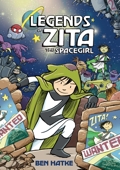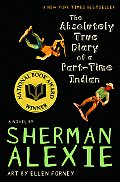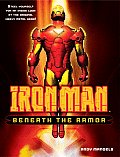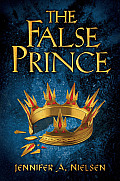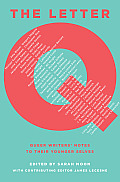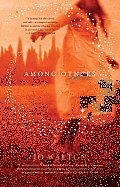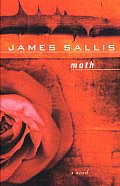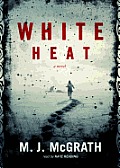Link to this review in the form of a comic strip by geneambaum tagged graphic novel • science fiction
Link to this review by geneambaum tagged humor • coming of age
Junior was born with water on the brain. He has an epic skull, huge hands and feet, terrible eyesight, headaches, and seizures. Everyone on the Spokane Indian Reservation calls him a retard. His parents are drunks, but at least they talk to him. Because he gets beat up once a month, he hangs out at home a lot, drawing cartoons and reading.
Rowdy is Junior’s best friend. They were born on the same day, in the same hospital. He’s also poor, and his father is a mean drunk. Rowdy is frequently bruised, bloodied, and prone to violence himself.
Then Junior decides to do what no Indian ever has: leave his crappy, hopeless high school for Reardon High, in the white farming community.
Why I picked it up: Many teen librarians I know said it was a good book.
Why I finished it: It was heartbreaking, but Junior always maintains his sense of humor. After he betrays his tribe, Rowdy hates him, along with most of the other people on the rez. At his new school he feels scared, worthless, and alone. But he can’t go back.
I’d give it to: Dan, who, like Junior, would have been a top draft pick of the Professional Masturbator’s League when he was a kid.
Link to this review by flemtastic tagged nonfiction • superhero
An exhaustive look into the history of the Marvel superhero Iron Man, from his humble beginnings in Tales of Suspense (March 1963), to the 2008 movie starring Robert Downey, Jr. There are dozens of color pictures and diagrams of the various incarnations of the Iron Man armor. The different creative teams that have worked on the comics over the years, including the illustrators and the rationales for their decisions, are detailed. Major villains have their place, too, in a character biographies section near the end, and fans will enjoy tidbits like the evolving appearance and actions of the Mandarin, a super-powered villain who first appears as a yellow-skinned Chinese caricature but has evolved into a slick Chinese businessman. Both successful and failed story arcs are covered, including reboots of the series.
Why I picked it up: I was getting ready for the premiere of Joss Whedon’s Avengers.
Why I finished it: Lots of bits from early Iron Man comics. Each change of armor and abilities is catalogued and demonstrated, along with first appearances, footnotes and much more. And at the end, each suit is shown in a full page Armor Gallery, including War Machine, my favorite.
I’d give it to: Mark, because he would appreciate the details on the various story arcs, which include failures but also spectacular successes like the landmark Tony-Stark-as-alcoholic storyline.
Link to this review by flemtastic tagged coming of age • fantasy
Sage is plucked out of his orphanage by Conner, a hard, cruel lord who fancies himself a patriot. Conner has gathered several similar-looking boys. Once they are on the grounds of Conner’s ancestral home, they find out the reason for their purchase, and also the mortal stakes of failing Lord Conner. Sage is in direct competition with the other boys to impersonate Prince Jaron, who has been missing for four years, in order to avert a war with neighboring countries. The losers will be put to death because of their knowledge of the plot.
As the night of succession draws near, only one thing is certain: Sage will either become king, or he will be dead.
Why I picked it up: A friend of mine is a middle-school librarian (as am I), and I read on her library’s Facebook page that The False Prince was the hottest book at her school.
Why I finished it: It reminded me very much of the cleverness of Megan Whalen Turner’s wonderful series starring Eugenides, the Thief of Eddis. Sage and his rebellious, defiant yet assured manner made me want to keep reading. Sage is hilarious, too. Upon being ordered to bathe, he washes only his body parts that are not covered by his clothing because washing more would be a waste.
I’d give it to: Keen, because this is the first book of a planned trilogy, and it looks like it is heading toward ground covered in Cinda Williams Chima’s Seven Realms series, of which we are both huge fans.
Link to this review by sarahhunt tagged anthology • essays • coming of age
Inspired by the letters from supportive adults that sustained her through her teen years, Moon asked gay, lesbian, bisexual, and transgendered authors to write a letter of encouragement to their younger selves.
Why I picked it up: One of the letters was a comic by the delightful Lucy Knisley.
Why I finished it: The letters brought back vivid memories of how I felt in my teen years: afraid I was the only one who felt different, afraid of rejection, wondering if I would ever have a first kiss or find someone who would fall in love with me. Julie Anne Peters comforts herself after her first heartbreak, Howard Cruse tells himself to look for the evidence in real life and his heart before believing self-appointed experts, Jaqueline Woodson meets a beautiful and mysterious green eyed woman who starts her wondering, and Martin Moran attempts suicide (twice) after his first sexual encounter.
I’d give it to: First I would travel back to the mid-80s and slip myself Erika Moen’s comic on how limiting it can be to try to make yourself and your orientation fit a label. (Both she and I have learned about how love can surprise you in the years since then.) But since I can’t travel in time, I will share this with Donna, my mentor when I was in library school. She and the writers collected in the book know that teens might not listen to these messages, so they need trusted adults around to rely on. (That’s why half of the profits from the book are going to The Trevor Project.)
Link to this review by billba tagged coming of age • fantasy • historical fiction
Morwenna and her twin sister practiced magic with the fairies in the overgrown industrial ruins of Wales. Then something terrible happened. Now she’s alone, with a crippled leg, being driven to boarding school in England by a father she only just met.
Why I picked it up: Mori’s world revolves around the science fiction and fantasy novels she reads. It takes place in 1980, just two years before I moved to England, and the books she reads are the ones I read by Heinlein, Niven, Le Guin, and so on. I couldn’t resist.
Why I finished it: Mori is the nerdgirl I always hoped to meet. I was a little jealous when she meets a boy at a sci-fi book club. But Mori really can do magic, and she bides her time, dealing with the petty politics of boarding school while preparing for the inevitable rematch with the being that killed her sister.
I’d give it to: Nigel, the first friend I made when I moved to England. We were both strangers in a strange land, and he’ll be freaked out by the nostalgic smells and sounds Walton evokes, especially the sweet buns, for a long time the only food in England worth eating, which Mori and the other girls consume in quantity.
Link to this review by geneambaum tagged mystery
Former thug and reluctant detective Lew Griffin has made a life for himself as a writer and French teacher at a New Orleans community college. But people around him need help to find those who’ve gone missing, to protect their friends, and to save them from themselves. When the widower of a woman he loved wants him to track down her missing daughter, Griffin goes on a journey that forces him to meditate on his past and present.
Why I picked it up: It’s one of my favorite books. (I originally read it because it’s the second book in the series, after the awesome The Long-Legged Fly.) And I talked the book group at the library where I used to work into reading it for their last meeting of 2011.
Why I finished it: Talking about it, I realized how personally I relate to Lew’s struggles with addiction because of similar problems in my family. He drinks but he’s mostly in control. He’s made a life for himself, but it could fall apart at any moment. And when he finally finds the young woman, he knows not to preach to her about stopping drugs because that choice is hers alone. (I read the book as full of hope, despite the dark world Lew inhabits.)
I’d give it to: Anyone. I buy copies of all of the books in this series whenever I find them in used book stores, and give them to whoever looks over the collection on my shelves.
Link to this review by sharonlevin tagged history • reference
Scandalous! made me realize that history is just a series of tabloid events that reverberate and resonate throughout the ages. Each story has a small gray square with “The Scoop” featuring a list of the players and a brief description of what happened. Scandalous! takes us through some historical highlights and links them to others, e.g. Leopold and Loeb are linked to other deadly duos throughout the ages (Bonnie and Clyde, the Menendez Brothers, Eric Harris and Dylan Klebold).
Each scandal also has “Why We Still Care” and “The Aftermath” sections to show its relevance today.
Why I picked it up: I love history and I love gossip, so it’s a perfect marriage for me.
Why I finished it: Each scandal is complete in a few pages, so it’s a quick read. I learned a lot in a short period of time. (I had never realized that celebrity lawyer F. Lee Bailey not only defended Patty Hearst, but also Sam Sheppard, whose case became the basis of The Fugitive.)
I’d give it to: Mayra, because books need to catch her interest immediately. She’d be interested in the murder of Lana Turner’s lover, Johnny Stompanato, because it links their abusive relationship to that of Rihanna and Chris Brown.
Link to this review by emilyjones tagged mystery • thriller • audiobook
Edie Kiglatuk is the only female guide in her Arctic village. The fact that she’s only half Inuit compounds the lack of respect she already feels from the elders.
On what should have been an easy hunting trip with two qalunaat (white) tourists, one is shot and killed by another hunter. Not long after, Edie’s stepson is found dead, too. He supposedly committed suicide, but she refuses to accept this. Relying on her skills as a hunter she investigates these seemingly unrelated deaths, and quickly begins to suspect that something sinister is happening out on the tundra.
Why I picked it up: I read Ordinary Wolves by Seth Kantner last year (awesome!) and relied heavily on a glossary of Inupiaq terms in the novel. When I discovered this audiobook I was excited to not only compare the differences of life in rural Alaska and on the Arctic tundra, but also to be able to hear the Inuit words spoken aloud.
Why I finished it: It’s old news, but I love suspenseful stories set in extreme cold. Reading’s narration made me reach for blankets more than once. (I also thoroughly enjoyed her pronunciation of unfamiliar words and would repeat them over and over.) I was wholly unprepared for the motivation behind the killings, and found myself grieving alongside Edie for the senseless loss of her stepson.
I’d give it to: Christine, who is a huge fan of Smilla’s Sense of Snow. She will appreciate the well-defined cultural clash between whites and natives, and will also be drawn into the cosmic mystery behind the murders.
